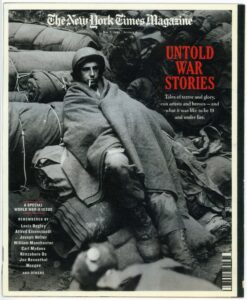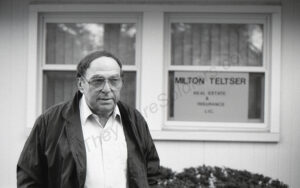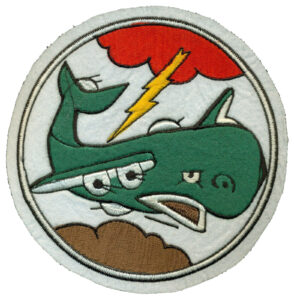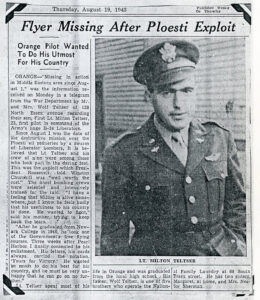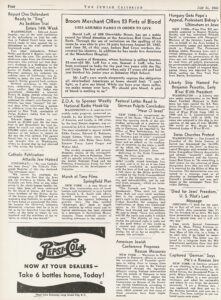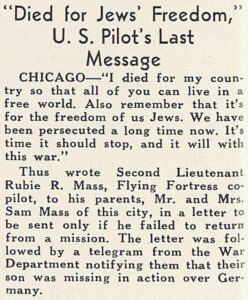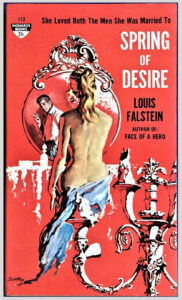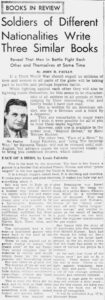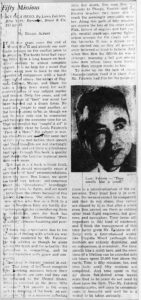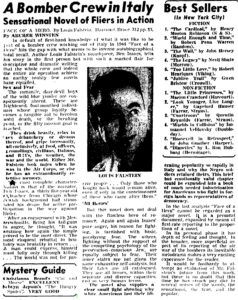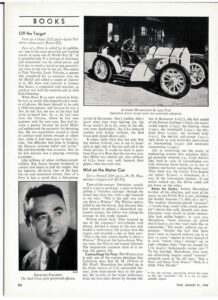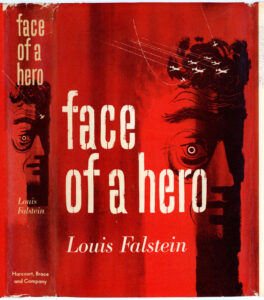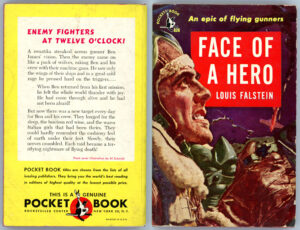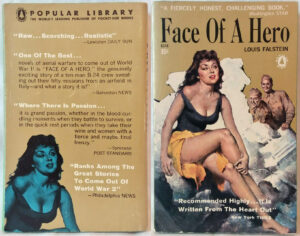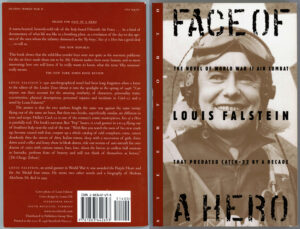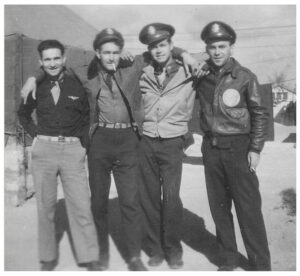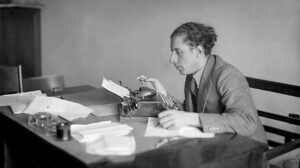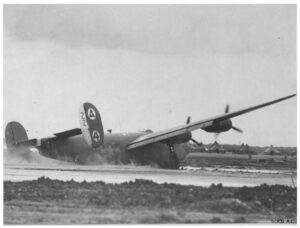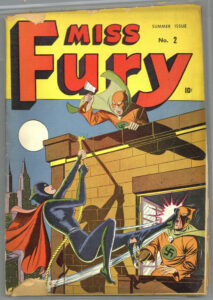C A T C H – 2 3 ?
Some works of literature present themselves to you as pure entertainment and,
once you are pulled into them, expand your mind with interesting and challenging ideas.
There is more in them than initially meets the eye.
Catch-22 proceeds in the opposite direction.
It presents itself as dealing with great issues
– and has nothing interesting to say about them.
Anyway, this book is so bad that the only real question it raises is,
how did it ever get to have the reputation it has?
Why is it on every “greatest novels of the twentieth century” list?
What the Hell?
I guess the answer is probably pretty simple.
It came out just before the Vietnam War (1961),
when a lot of people would soon start thinking that war is a very bad thing,
and that the military consists mostly of vicious idiots.
In other words,
Heller got a free ride
because he was telling a lot of people something they already believed
and already wanted to hear.
– Lester Hunt, May 27, 2007
__________
__________
But, to paraphrase Kingsley Amis’s line about breasts,
we know why the critics liked it, but why did they like it so much?
As if in a perverse Pied Piper story,
a host of elders followed their capering children toward willed ignorance.
And one of the more effective tunes in the piper’s repertoire was Catch-22.
Ironically, while Catch-22 has been lauded relentlessly as a picture of a lunatic world
where nothing makes sense,
“a swamp of absurdity,” as Frederick Karl termed it in 1965,
in fact everything in the novel makes sense—
the kind of sense contrived by the politically paranoid mind.
– Alec Solomita, March, 2008
__________
__________
Face of a Hero presents such situations [moments of irony and absurdity] again and again.
But what goes along with these descriptions is the powerful sense of human dignity.
We are left with Pop Isaacs, and he is a good man.
He has his limitations, as does the novel, which has some overwriting and flat spots.
But because the light Pop shines is ordinary, it is all the more powerful.
– M.T. Kelly, 1999
__________
“…and after the fire a still small sound.”
– I Kings, Chapter 19, Verse 12
________________________________________
Sometimes, the only way to reach your destination is through a journey in an opposite direction.
At least, for a while.
In that sense, this exploration of Louis Falstein’s 1950 novel Face of a Hero has inevitably involved a comparison with the book’s accidental 1961 counterpart, Catch-22, in terms of the obscurity of the former and the enduring success and cultural impact of the latter. Having presented the two book reviews (by Nelson Algren and Robert Brustein) which were central in catapulting Catch-22’s to enduring prominence, and, a statistical comparison of the novels’ history, this fourteenth (gad, that many?!!) and “last” post approaches Heller’s novel from a third perspective: The book’s meaning and message.
Below, you’ll find essays by Norman Podhoretz, Lester Hunt, and Alec Solomita that taken together, catch Catch-22 – its ethos and world-view – from standpoints moral and philosophical as much literary and cultural, and decisively counterweigh the novel’s entirely undeserved acclaim. Likewise, equally substantive; equally penetrating perspectives on Heller’s novel can be found at GoodReads and Mr.BezosStore, though, for the sake of brevity (?!) I won’t include them here. And, I wouldn’t be surprised if even during the 60s and 70s some in the worlds of academia, publishing, and entertainment had similarly critical views of Heller’s novel, but felt unable – for reasons of career security and social pressure – to have broached their opinions in the academic or popular press.
Let’s start with Norman Podhoretz.
In 2000, five years after Louis Falstein’s death and one year after Joseph Heller’s passing, his essay “Looking Back at Catch-22” appeared in the February issue of Commentary, and – moving beyond the perspective of Catch-22 as a literary work – discussed the novel’s unarticulated message, and, its cultural and political significance. Podhoretz was entirely correct in suggesting that the success and influence of Catch-22 had vastly less to do with the novel’s quality as a story; as literature, than it did with conforming to, reflecting, and validating currents of sociological and ideological fashion then (and now) prevailing in American society. His article was followed three months later by six responses (only a few, I suppose, of many received), two of which offered criticism of Podhoretz’s thoughts from sensible but limited perspectives, while the other four affirmed – some staunchly; some with gratitude; all with appreciation – the validity of his opinions.
Next came Lester Hunt’s pithy 2007 and still fortunately still-accessible blog post, “The Most Overrated Novel of the Twentieth Century”, which leaps right out ‘o the gate, hits the ground running, and goes full throttle to its conclusion.
I can’t recommended his analysis of Catch-22 highly enough.
(Completely off topic! Though I’m certain not at all intended as such (!), Hunt’s use of the very word “overrated” suggests to me the category of the “Most Overrated Song Ever”, for which I unreservedly offer my own recommendation.)
At first, Hunt briefly addresses Heller’s novel in terms of its effectiveness (not much) as a work of humor and satire. Moving to the meat of his argument, the bulk of his critique approaches the novel from standpoints of logic, ethics, and morality. His thoughts about the novel’s fame segue from those of Podhoretz, in that he deems the success of Catch-22 as being attributable to an intersection between cultural coincidence and literary calculation. While Podhoretz felt (correctly) that the novel reflected and found validation in avant-garde currents of thought in the worlds of poetry, literature, and the therapeutic culture, Hunt zeroes in on something more pragmatic: The novel, released just a few years before the height of the war in Vietnam, cast the military – and those who serve in it – as by definition and nature a force of malevolent incompetence (or, would it be incompetent malevolence?!), in that it was “…telling people what they already believed and already wanted to hear”. In this (as aptly described by Robert Pickus, Judith Hirsch, Louis Lyons, and Larry Thornberry in their letters to Commentary) Heller’s novel was far less literature than it was a contrived, shallow, and (especially!) lengthy form of rationalization.
Coming on the scene one year later was Alec Solomita’s New Criterion essay “Yossarian Section”.
Unlike Podhoretz and Hunt, Solomita starts his discussion of Catch-22 on a personal level, for he read the book at the age of fifteen, when such things – anything, really! – do make an impact. He pays particular attention to an aspect of the book’s message that made the novel so popular and appealing: “Crammed with allusions to scripture and mythology, to Synge, Sartre, T.S. Eliot, and Washington Irving, the novel simultaneously flattered and challenged bookish young baby boomers.” There was also the novel’s message of anti-authoritarianism: “We pubescent malcontents … were captivated by the cowering Yossarian’s “free, rebellious spirit in this explosive, bitter, subversive, brilliant book.” … Yossarian felt the same way about fighting in World War II as we felt about gym class.” But, this more than exaggerated equivalence could’ve only been arrived at through Heller’s use of comedy and word-play, the impact of which, however, eventually peters out: “As astute critics have pointed out, Heller’s “anarchic” and “savage” humor cannot withstand the novel’s last-minute swerve toward ethical self-justification.”
Like Podhoretz and Hunt, Solomita peers into Heller’s novel from the vantage point of history, identically realizing that its success was attributable to its timing, which coincided with the war in Vietnam, dramatic changes in domestic politics, and a dramatic metamorphosis in social mores.
My own “take” from Solomita’s words is that these events and transformations – “powerful stimuli” (visual media?; pop culture?; advertising?) – affected American society to such an unprecedented degree that, “…it was a formidable challenge to think as well as to feel.” And here, we come to the illuminating core of Solomita’s argument, as relevant to 2022 as the 1960s:
“Nor was it easy to look at the brutal war in Vietnam in a larger, geopolitical context – or to say “no” to drugs. Not only did fifteen-year-olds fail to meet this challenge, but sober adults previously able to differentiate between Republicans and Nazis, between authority and authoritarianism, between tolerance and license, also lost their way.”
“Like ideologues before them who simplified a variety of hypocritical politicians, greedy businessmen, and corrupt military men into a single evil entity – Catholicism, capitalism, Jewry – Heller and numberless other more or less talented malcontents invented out of a multiplicity of interests the shapeless monstrous entity known as the “military-industrial complex” or “mass society,” against which they can throw a perpetual tantrum.”
A la 1961, Nelson Algren.
A la doubly 1961, Robert Brustein, who, “…talked about American society as if it suffered under the benighted regimes of Hitler or Stalin and not the prosperity and hopes of the New Frontier, the Civil Rights movement, and, soon, the “Great” Society.” A society, where, the reader, “…if he can’t attain to the elite class to which the reviewer belongs – one of “the few Americans who care” – feels compelled to ask, “Who is this masked man, this ‘mass society?’”
A la thricely 1999, Sanford Pinsker, who, “…assail[ed] the sickness of the “contemporary world, in its shameless greed and thorough-going corruption.”
A la 2008, where, “…it is a commonplace that fighting against this “system” is a virtue while, of course, fighting for it makes no sense at all.”
A la, 2022, and beyond?
____________
“I Am the Bombardier!”
In her response to Norman Podhoretz’s February, 2002 Commentary article about Catch-22, Judith Hirsch observed, “There was a murderous nation on the loose that had to be stopped, and all the sophistry in Heller’s arsenal could not lessen the evil of the Germans. As a Jew, Heller should have been sensitive to the slaughter of his people. Instead, he fashioned a novel about the war as if it involved no moral imperative.” Given the importance of Sergeant Ben Isaacs’ identity as a Jew to the narrative of Face of a Hero, what of the intersection between the identity of Joseph Heller the author, and – if one can be so direct – Joseph Heller, the Jew, for Catch-22?
There are two answers to Mrs. Hirsch’s critique, which call to mind overlapping topics of Jewish identity, Jewish solidarity, and Jewish assimilation. These are perennial and seemingly inevitable aspects of the nature of Jewish existence are not only addressed in the Tanach, but have been an enduring focus of fiction, non-fiction, and both theological and secular commentary, ever since the halting beginning of Jewish political emancipation some centuries ago.
The first answer to her question is from the year 1940.
In that year, just nine months after the Second World War commenced, an article by Shlomo Katz was published in May, 1940 issue of the Jewish Frontier, entitled, “What Should We Write? – Present day dilemma of American Jewish writers“.
Katz’s thoughts anticipated questions about the response of American Jewry to the Shoah that have persisted since the 1970s. Though – ironically! – pertaining to specifically American Jewish w-r-i-t-e-r-s in terms of the centrality (or, uhhhh… the lack thereof) of the historical experience of the Jewish people as subject matter for their work, a key passage within Katz’s text can be extrapolated, in time as much as place (any time and any place) to a span incalculably wider.
Here’s the passage that provides an answer to Mrs. Hirsch’s question. (Italics are my own.)
“…why doesn’t he choose Jewish themes for his work, in addition to the others that had been haunting him? This, precisely, is his dilemma. He frequently cannot. Born or raised in this country, the process of cultural assimilation has progressed quite a distance. The ties that bind the young Jewish writer to Jews are almost certainly entirely those with the immediate Jewish community with which he comes in contact, whose peculiarities he not only knows but also shares. The concept of the Jewish people throughout the world as a unit may not be strange to him ideologically; he may even argue in favor of such a concept where political theories are concerned. But personally he has already lost the feeling of unity with the larger whole to a great extent. Only the slimmest cultural and psychic ties bind him to Jews of Poland, Palestine, Germany or Russia. That is why he cannot feel about the tragic fate of the European Jews in the same distant and detached terms as he feels about the fate of the Chinese people, for example. But at the same time he is too far removed from them to be able to identify himself with Polish or German Jews in a personal manner. The immensity of the tragedy appalls him; he feels directly concerned, but not sufficiently to make him a living part of the drama. Between him and the European scene there lie years, years that count in building up one’s personality, of life in America. These years, with all the cultural baggage that was accumulated in them, he does not share with Europe’s Jews; and they stand between him and them.“
To put it differently – given time, human nature, and absent of externally (* ahem *) imposed events and influences – as has happened throughout the history of the Jews, the sense of collective identity of each successive generation, and especially, the consciousness of each generation as being a living connection between past and future will contract and diminish inward upon itself. First to memory. Then to sentimentality. Then to a mere genealogical fact. And finally, to an invisible point beyond an inaccessible horizon.
The second answer to Judith Hirsch’s question is from 1995, and comes by unintended and direct way of Joseph Heller himself, in the form of an essay in the May 7, 1995, edition of The New York Times Magazine, a special issue entitled “Untold War Stories”, the theme being the fiftieth anniversary of WW II’s end.
Here’s the cover:
Among the magazine’s fifteen essays and stories, including contributions by Robert Kotlowitz (whose disconcerting and highly-praised memoir Before Their Time just may feature in a future post), Walter Sullivan, fabulist William Manchester, and Louis Begley, is Joseph Heller’s retrospective “I Am the Bombardier!”, which appears on page 61.
Heres the essay:
Even granting the limitations on length imposed by a one-page magazine format, in the following passage – by what’s absent just as much as by what’s present – lies Heller’s unanticipated response to Judith Hirsch’s observation:
“I loved Denver. It was winter, but it was a beautiful winter, the kind of winter you never see in New York. This was my first time out of New York except for maybe one trip to New Jersey as a kid. That was part of the excitement of it, the adventure. Also there was a feeling that you were doing something that was socially approved and esteemed. In Denver, and then wherever I went, there was always a list of families that wanted to have servicemen for dinner. They didn’t care if you were from Coney Island. They didn’t care if you were Jewish. They might have cared if you were black. Well, they might have cared if you were Jewish. One of the things that surprised me was how courteous and generally warmhearted people are outside New York. There’s an affection and optimism that New Yorkers are not accustomed to. And there’s also very slow service in luncheonettes.”
That’s it; that’s that.
Here, being a Jew is understood in terms of one’s potential for acceptance by the surrounding society. Any sense of identification with or connection to European Jewry in the context of the European war, let alone an appreciation of the scope of Jewish history – whether visceral or intellectual; whether political or historical; whether in a retrospective or contemporary context; whether far or near – is absent (Well, the essay’s venue is The New York Times, after all!)
That’s that; that’s it.
But, to be fair to Heller, in this attitude he was neither unusual nor unique. Perhaps the predicament and fate of the Jewish people during WW II, if irrelevant to him during the war itself, remained so nearly two decades later, during the writing of his first novel.
Anyway, we know that Joseph Heller served as a bombardier, but in light of Shlomo Katz’s 1940 essay and Heller’s 1995 Times Magazine piece, what does this suggest about the creation and identity of the novel’s protagonist, Captain John Yossarian?
To this question my answer is equal parts conjecture and intuition, for – admittedly – I’ve not read any popular or academic biographies of Joseph Heller, his 1998 memoir Now and Then: From Coney Island to Here, academic studies of his work, or his novels subsequent to Catch-22. (Okay, his biography at Cliff’s Notes is helpful!)
What I know of his literary oeuvre through the selection of articles, reviews, and essays appearing in this series of blog posts, and, resources on the web. But:
Like every person, Joseph Heller lived amidst and was formed by a unique combination of influences. Cliff’s Notes mentions that his father Isaac, “…was agnostic, (and) interested in socialist politics.” His Wikipedia entry (okay, yeah, so it’s Wikipedia, but still!) mentions that postwar, Heller studied English at USC and NYU, graduating from the latter in 1948, and attaining an M.A. in English from Columbia in 1949. This was followed by an interval as a Fulbright Scholar at St. Catharine’s College in Oxford, and then, teaching composition at Penn State. Next came positions as an advertising copywriter for Time (1952–56) and Look (1956–58), and, promotion manager for McCall’s (1958–61).
As far as Heller’s identity as a Jew – whether in terms of being a Jew, or instead being Jew”ish” (Major Major Major Major emphasis on the “ish“?) – this seems to have influenced the creation of (the disguised?) Bob Slocum in 1974’s Something Happened, and, the quite emphatically undisguised Bruce Gold (and extended family) in 1979’s Good as Gold. But – admittedly conjecture on my part – it essentially seems to have become (perhaps it always was; perhaps given his life circumstances it could never have been otherwise) simply a nominal sense of ethnicity.
As for the good fictional Captain himself?
The Wikipedia entry for Yossarian states that, “As to the origins of the name … later documented in his autobiography … Heller noted that he derived the name Yossarian from a wartime friend and fellow bombardier, Francis Yohannan. Yohannan made the military his career, continuing to serve through the Vietnam War, placing him at odds with Yossarian’s feelings towards the military and as noted in his obituary (Yohannan) turned aside calls from reporters who asked if he was the real-life Yossarian. … The exotic name “Yossarian” was chosen by Heller to emphasize his protagonist’s detachment from mainstream military culture. Yossarian’s name is described as “an odious, alien, distasteful name, that just did not inspire confidence. … It was “…not at all like such clean, crisp, honest, American names as Cathcart, Peckem and Dreedle.”” And, in his 1998 memoir Now and Then, “Heller admitted in later years that the name ‘Yossarian’ was derived from the name of one of his Air Force buddies, Francis Yohannan – an Assyrian – but that the character of Yossarian himself was ‘the incarnation of a wish’.” (Well, what was that wish?)
Of course, infinitely more central to the novel than the bombardier’s mere name are his beliefs, fears, and actions. A possible source for the narrative of the Captain’s misadventures and his efforts to be relieved of combat duty may have been Lt. Julius Fish, another 488th Bomb Squadron bombardier and a wartime friend to both Yohannan and Heller, whose story is related here.
However, David Margolick’s 2015 Wall Street Journal article “Inventing the War Novel” casts the creation of Yossarian in a very different light: “It surely signified something about the progress that American Jews had made that, when Heller wanted to make his hero an outsider, casting him as a Jew no longer worked. So he turned him into an Assyrian, or Armenian, or something. Only many years later did Heller admit that, whatever his official ethnicity, Yossarian was really “very Jewish.” (Unfortunately, Mr. Margolick doesn’t list the source of Heller’s admission!)
I want to suggest another explanation.
In light of Margolick’s quotation of Heller’s comment concerning Yossarian’s true background, perhaps Catch-22’s author created such an “alien, distasteful name” not because it was unlike surnames of European origin then prevalent in the United States, but, out of disguised familiarity: The “sound” of of the name implies ethnic ancestry from the lands of Asia Minor or not-so-indirectly the Levant – the ancestral and enduring homeland of the Jews. Yet at the same time, by its “Assyrian” (!?) (or Armenian) “ring”, it was ambiguous and unusual enough to avoid any definitively Jewish connotation. In light of this, perhaps the protagonist, his name, and his identity represented Heller’s compromise between the “raw material” of life which which he was already deeply; immediately familiar – in terms of family, ethnicity, and culture – on one hand, and uncertainty about the acceptance and publication – whether in the literary world or by the general public – of a novel featuring an unambiguously Jewish hero (anti-hero?), on the other.
I don’t know if this was so. But if so, it would’ve been unwarranted, given the number and variety of works of fiction from the post-WW II decades which unapologetically featured matter-of-factly neutral or positive Jewish heroes and protagonists. Examples include works by Irwin Shaw and James Jones, let alone Falstein’s Face of a Hero.
And yet, an echo:
Yossarian strikes me as being reminiscent of two characters from Rodger’s and Hammerstein’s Oklahoma! of 1943: Jud Fry, and especially (especially!) the “Persian Peddler” (seriously! – a P e r s i a n peddler?) Ali Hakim, who though certainly not explicitly Jews, as noted by Bruce Kirle, Derek Miller, Andrea Most, are certainly symbolic representations of Jews, in a play whose theme – quoting Miller – is “partially an examination of the place of Jews in American society”. The difference of course being, that Yossarian is entirely central to Heller’s story.
And yet, an echo of an echo:
Michael Igor Peschkowsky’s (Mike Nichols’) and Henry Zuckerman’s (Buck Henry’s) 1970 Catch-22 features Alan Arkin in the role of Captain Yossarian, while the 1943 stage production of Oklahoma! features Joseph Buloff in the role of Ali Hakim. Again, is it by design, chance, or synchronicity or something stranger that in both cases Jewish actors are cast in the roles of characters who, while not explicitly Jews by name or description, conform to the larger society’s cultural template of Jews?
So, I wonder if Joseph Heller’s reasons for the conceptualization and creation of Captain Yossarian were as mundane as they were pragmatic, and really had little to do with the “progress” – whether real or ostensible – American Jews had made by the late 1950s that had transformed them to “insiders”, and, made them dramatically uninteresting.
____________________
Anyway… The deeper issue suggested by Judith Hirsch’s letter revolves around the degree to which the persecution of the Jews of Europe was a motivational factor in the military service of American Jews during the Second World War.
I really don’t know (though given the tenor of the times, I very seriously doubt) if any interviews were ever conducted among American Jewish soldiers in “real-time” during that conflict, concerning their knowledge about the dire plight of European Jewry, or, cognizance of the Shoah itself.
However, if I were to venture a guess, I think the opinions of this vast group of men would’ve simply and inevitably reflected the spectrum of opinion of American Jewry at that time as a whole:
At one end apathy, if not complete indifference.
In the much larger center, a general awareness (with neither specific nor accurate knowledge) that an awful fate had befallen the Jews of Europe, which nonetheless – among a myriad of immediate personal concerns, whether mundane, pressing, or dire – never was the real center of one’s attention.
At the opposite and far distant end, among a committed and vanishingly small minority, a focused consciousness and steeled urgency which, alas, only on very rare and exceptional occasions (the United States having entered the European land war (the invasion of Italy commencing on September 3, 1943, well after the majority of the Jews killed in the Shoah had already been murdered – and primarily in Eastern Europe) could be translated into physical action.
In terms of the military service of American Jews, I think this was reflected in wartime news coverage in both the Jewish and general press. Though innumerable articles and stories about the experiences of American Jewish servicemen were published in both venues during the war, within in the American English-language news media (I really don’t know about the perception and coverage of this topic in the American Yiddish press), only in a vanishingly small number – less than a mere statistical “blip’ – have I found expressions of a soldier perceiving his military service in the context of the survival of European Jewry.
As in two.
As in the number “2“.
As follows below.
One item, published in the New York Post, pertains to Milton Teltser, a B-24 pilot shot down over Ploesti on August 1, 1943, during Operation Tidal Wave.
Another, from Chicago’s Jewish Criterion, relates to 8th Air Force B-24 co-pilot Ruby Mass.
These articles are preceded by the trailer for Hulu’s 2019 production of Catch-22. Very nicely done from a cinematic point of view, the trailer is set to start at the point where Captain Yossarian (Christopher Abbott) exclaims, “It doesn’t make a difference who wins the war to someone who’s dead!”
While this is only a single sentence in a min-series of over 4 1/2 hours duration, this line of dialogue (written by Luke Davies and David Michôd?), despite its undeniable and appealing logic, somehow stands against the words and thoughts of Mass and Teltser (and how many others, whose names and thoughts remain unknown?). Taken to its logical conclusion – and understood in the light of Roger Scruton’s discussion of the nature of citizenship in The West and The Rest – more than posing a nominally legitimate question about courage and cowardice, survival and death, it espouses a philosophy that severs all links between past and present, and present and future, without which a people, society, nation, and civilization cannot survive.
In light of the state of the United States in particular and the “West” in general, in this closing month of 2022, perhaps this is intentional.
As to why, that’s another essay.
____________________
So, we’ve come (for now?!) to the end to my series of posts about Face of a Hero.
And so, in literature; as in the arts; as in any and all measures of “life” – in general, “…the race does not belong to the swift, nor the war to the mighty; neither do the wise have bread, nor do the understanding have riches, nor the knowledgeable, favor; for time and fate will overtake them all.”
And so, two novels. One ostensibly simple, but of in reality of profound depth and meaning. Another superficially sophisticated and supposedly clever, but in actuality entirely one-dimensional and extraordinarily shallow. That the former soon fell into obscurity, while the latter rose to fame (and remains so) is little more than a testimony to the “way of the world”; to the ephemeral currents of academic and cultural fashion.
To conclude, we’ll leave Catch-22 deservedly behind (far behind!), and circle back to Face of a Hero, via M.T. Kelly’s 1999 book review “The Teachings of Warfare”, from the National Post.
Even with the passage of a half-century since the book’s 1950 publication, Kelly perceives the same strengths as did several reviewers upon its first publication. He sees Falstein’s novel as having three principle themes, these being an exploration of courage – and the ability to master fear; the nature of comradeship – despite the very faults of one’s comrades; and, hope – in the face of disillusionment and cynicism.
Though some reviewers, in the 1950s and even more in the late 1990s, opined that the story was unnecessarily direct and conventional, Kelly (rightly) sees that the book’s, “…plain style, seeming only to swim on the surface of situations, reveals truths in the way of the best literature.” At the core, the novel’s ostensible simplicity is the foundation for a tale of how a man maintained his belief, sense of self-worth, and, connection to other men (many of whom were in the same predicament), despite challenges that otherwise might have seemed insurmountable.
This is stuff of literature, for this is the stuff of life.
________________________________________
On to the articles, letters, and retrospectives.
February, 2000, Commentary, Norman Podhoretz, “Looking Back at Catch-22“
May, 2000, Commentary, “Letters from Readers, “Catch-22”“
Catch 22 (1970) Trailer, via Blazing Trailers YouTube channel
May 27, 2007, Lester Hunt’s Blog, “The Most Overrated Novel of the Twentieth Century” (I also suggest Mr. Hunt’s excellent posts Avatar, and, Nazism or Communism: Which is More Evil? Among others!)
May, 2008, The New Criterion, Alec Solomita, “Yossarian Section (A review of Joseph Heller’s Catch-22 (Bloom’s Modern Critical Interpretations, by Sterling Professor Of The Humanities Harold Bloom.)“
Catch 22 (2019 Hulu Miniseries) Trailer, via Hulu YouTube channel
(— the final article —)
March 13, 1999, National Post [National Edition] Don Mills, Ontario, Canada, M.T. Kelly, “The Teachings of Warfare“
____________________
LOOKING BACK AT “CATCH-22”
… until the novel begins winding down to its conclusion,
there is scarcely a mention of Nazism and fascism as evils that might be worth fighting against,
or of anything about America that might be worth fighting – never mind dying – for.
If Heller had raised any of these considerations earlier,
his point of view would have been put under more pressure and a greater degree of resistance
than he actually allows it to encounter throughout most of the book.
*****
Heller’s novel played perfectly into the conviction of the radical movement of the 60’s that this country,
and its armed forces above all, were ruled by an “establishment” made up of madmen and criminals.
Moreover, in identifying sanity with an unwillingness to serve the purposes of this insane society,
Heller was also perfectly in tune with a doctrine that was being preached by most of the major gurus of the era,
including writers like Allen Ginsberg and Ken Kesey, and psychiatrists like R.D. Laing.
As Heller himself, speaking directly in his own voice,
once put it in summarizing what he had been getting at in Catch-22:
“Frankly, I think the whole society is nuts – and the question is: what does a sane man do in an insane society?”
Norman Podhoretz
Commentary
February 2000
(Volume 109, Issue 2)
THIS PAST December, upon hearing that Joseph Heller had just died at the age of seventy-six, James Webb took to the op-ed page of the Wall Street Journal, where he delivered himself of a fervent tribute to Catch-22, Heller’s first, best (by far), and still most famous novel. There was nothing peculiar or remarkable in itself about Webb’s gesture; tributes to Heller were appearing everywhere at the same time. And like Webb’s, almost all of them dwelled entirely on Catch-22, which came out in 1961 and which subjected World War II to a satirical treatment whose hilarity was matched only by its savagery. Scarcely a mention was made by anyone of the five lesser novels Heller published in the following thirty-eight years of his life–his seventh is scheduled for posthumous publication in the fall–or of the two plays and the two works of nonfiction he also wrote. (The only exception I came across was a little obituary by David Remnick in the New Yorker that entered a plea for Heller’s second novel, Something Happened.)
No doubt many other pieces about Catch-22 will have been produced by the time this one gets into print. No doubt, too, most of them will be as effusive as Webb’s. Indeed, the day before he pronounced it a “masterpiece” and a “great novel,” an appreciation in the Washington Post, run as a sidebar to Heller’s obituary, ended with the similarly confident assertion that Catch-22 would “live forever.”
For all that, however, Webb’s piece was special–and what made it special was that it came from a graduate of the Naval Academy who went on to fight with great bravery as a marine in Vietnam, where he was wounded and much decorated, and who later was appointed Secretary of the Navy by Ronald Reagan. One might have thought that such a person with such a background would have a reservation or two about a book that ridicules war and the military with a relentlessness that must surely have inspired the envy of many a pacifist.
Not a bit of it. So far as Webb is concerned, Catch-22 is without sin of any kind, and its “lasting greatness is beyond dispute.” It is a greatness that lies in the truths Heller reveals about war:
His message…was that all wars dehumanize. That few soldiers march happily to their fate. And that once the bullets start to fly, all battlefields become apolitical. For while there may be few atheists in a foxhole, there are even fewer politicians.
This, as we shall soon see, is actually a rather toothless paraphrase of Heller’s far more brutal “message.” Slightly more biting, but still misleading, is Webb’s praise of Catch-22 for having “stripped away cant and hypocrisy from the telling of how difficult it is to serve” in war. In Webb’s judgment, Heller thereby performed a salutary exorcism on the’ “national mindset that was nothing short of adamant in its insistence on the fatalistic bravado with which our soldiers had faced death” in World War II.
Webb, like Heller, is convinced that this mindset was delusory. But was it? I would concede that it may well have been romantically one-sided, but was it any more unbalanced than Heller’s own mindset, or Webb’s?
To CST some notion of what is omitted from Catch-22, let alone from Webb’s sanitized rendering of Heller’s “message,” one need only glance at the work of literature that Heller himself said had exerted (in the words of one obituary notice) “perhaps the longest-lasting impression on him.” This was a prose translation of Homer’s Iliad that he read as a boy, and that inspired in him the ambition to be a writer.
Now it is certainly the case that the side of war upon which Catch-22 dwells exclusively and obsessively–its grisly horrors, and the human pettiness it can elicit–are vividly recorded in the Iliad. (Remember Achilles sulking in his tent and refusing to join in battle because one of his concubines has been taken from him by the commanding general Agamemnon?) But in Homer’s epic, all this is intermingled with the great virtues that war also elicits, and of which the poem sings even more melodiously. These virtues–courage, honor, sacrifice, nobility–also make an occasional appearance in Catch-22, but mainly in order to be given as ferocious a beating by Heller as the one he administers to war itself.
So ferocious, indeed, that no one deeply influenced by this novel would ever be able to understand why a self-professed American pacifist like the philosopher William James could come to believe in the great need for a “moral equivalent of war” in addressing the problems of a society at peace. Furthermore, James insisted, “One cannot meet [the arguments of the militarists] effectively by mere counter-insistency on war’s horror. The horror makes the thrill; and…the question is of getting the extremest and supremest out of human nature …. The military party denies neither the bestiality nor the horror…; it only says that these things tell but half the story.”
Even more puzzling to a reader entirely under the sway of Catch-22 would be the remark made by another pacifist philosopher, Bertrand Russell. Sitting in a British jail for having agitated against conscription in World War I, Russell later wrote, “I was tormented by patriotism. The successes of the Germans…were horrible to me. I desired the defeat of Germany as ardently as any retired colonel.”
And yet, bewildering as such sentiments might seem to anyone caught up in the worldview of Catch-22, they nevertheless mainly account for the less than enthusiastic reception of the novel when it was first published in 1961. Having become embroiled in the debate over it then, I can testify that one of the reasons for this lack of enthusiasm was precisely the uneasiness caused by its portrayal of World War II.
This was to be expected. In 1961, there were very few people around who took a negative view of the war against Hitler and Nazism; or to state it more strongly, practically everyone thought it had been a just and necessary war and that we as a nation had every reason to be proud of our part in it. To be sure, admitting that they were denigrating Catch-22 because they were offended by its “message” would have violated the literary canons of the day, according to which a work of art was supposed to be judged strictly on aesthetic grounds. Consequently, many of the early reviewers pounced instead on Catch-22’s literary weaknesses of structure and narrative. The New York Times Book Review, for example, gave it only a short notice on page 50 complaining of its “want of craft and sensibility.”
What kept the novel from getting lost as a result of this largely dismissive reception was that a few critics sprang to its defense. I was one of them. But the line of argument we tended to follow did not focus on war in general or World War II in particular. Forgetting the critical rule that Moby-Dick, whatever symbolic meaning it may have, is first of all about the hunt for a whale, I even claimed that Catch-22 was only “ostensibly” about an air-force squadron in World War II. Its real subject, I maintained, was the nature of American society in the mid-20th century.
Nor was I the only defender of Catch-22 who advanced this interpretation. As participants in a nascent new radicalism, some of us took our cue from an essay by Heller’s younger contemporary and fellow novelist Philip Roth, which lamented that this country sometimes seemed like a gigantic insane asylum that was virtually impossible for the writer of fiction to describe “and then make credible.”[1] Heller’s achievement, we argued, was that he had found a way to do just that. And that he should have done it through a portrayal of what was then almost universally regarded as America at its best–here was where World War II came in–rather than firing easy shots at the obvious shortcomings and faults of the country, seemed to us veritably heroic.
This was why my own main criticism of Heller was not that he had defamed World War II but that, instead of carrying this breathtakingly brazen enterprise to its logical conclusion, he had suffered a loss of nerve at the end that did serious damage to the integrity of his novel as a satire.[2]
AS ALL the world knows by now, the hero of Catch-22 is a bombardier named Yossarian who is convinced that everyone is trying to kill him. This makes various people angry, especially his friend Clevinger, who is serving in the same squadron. Clevinger is a man who believes passionately in many principles and who is also a great patriot:
“No one is trying to kill you,” Clevinger said.
“Then why are they shooting at me?” Yossarian asked.
“They’re shooting at everyone,” Clevinger answered. “They’re trying to kill everyone.”
“And what difference does that make?”
Clevinger and Yossarian are each certain that the other is crazy. In fact, so far as Yossarian is concerned, everyone is crazy who thinks that any sense can be made out of getting killed. When Yossarian is told that people are dying for their country, he retorts that as far as he can see, the only reason he has to fly more combat missions is that his commanding officer, Colonel Cathcart, wants to become a general. Colonel Cathcart is therefore his enemy just as surely as the German gunner shooting at him when he drops his bombs.
Everywhere, Yossarian reflects in contemplating the war, men went mad and were rewarded with flying medals. Boys on every side of the bomb line were laying down their lives for what they had been told was their country, and no one seemed to mind, least of all the boys who were laying down their young lives.
But Yossarian minds so powerfully that he himself is carried to what might seem the point of madness. Not, however, in Heller’s eyes. There is not the slightest doubt that he means us to regard Yossarian’s paranoia (even though it extends to a nurse in the field hospital who dislikes him and to bus drivers everywhere, all of whom are trying to do him in) not as a disease but as a sensible response to real dangers. For example, we are shown that his diagnosis of Colonel Cathcart–and all the other senior officers whom he also dismisses as insane–is accurate. The madness lies not in him but in them and the system over which they preside.
This system is governed by “Catch-22,” which contains many clauses. The most impressive we learn about when the flight surgeon Doc Daneeka explains to Yossarian why he cannot ground a crazy man, despite the fact that the rules require him to ground anyone who is crazy. The reason is that the crazy man must ask to be grounded, but as soon as he asks he can no longer be considered crazy–because, according to Catch-22, “a concern for one’s own safety in the face of dangers that are real and immediate is the process of a rational mind.”
Doc Daneeka’s terror of death is almost as great as Yossarian’s, and his attitude toward the world is correspondingly similar: “Oh I’m not complaining. I know there’s a war on. I know a lot of people are going to suffer for us to win. But why must I be one of them?”
WHAT IS the war in Catch-22 all about? For approximately the first three-quarters of this 442-page novel, the only answer anyone ever seems able to offer is that, in an armed conflict between nations, it is a noble thing to give your life for your own. This proposition Heller takes considerable pleasure in ridiculing.
“There are now 50 or 60 countries fighting in this war,” an ancient Italian who has learned the arts of survival tells the idealistic and patriotic nineteen-year-old Lieutenant Nately. “Surely so many countries can’t all be worth dying for.” Nately is shocked by such cynicism and tries to argue, but the old man shakes his head wearily. “They’re going to kill you if you don’t watch out, and I can see now that you are not going to watch out.” (As though to nail down his acceptance of the ancient Italian’s perspective, Heller makes sure that this prophecy later comes true.) And in response to Nately’s declaration that “it’s better to die on one’s feet than to live on one’s knees,” the old man tells him that the saying makes more sense if it is turned around to read, “It is better to live on one’s feet than die on one’s knees.”
The interesting thing, as I noted at the time in my own review, is that until the novel begins winding down to its conclusion, there is scarcely a mention of Nazism and fascism as evils that might be worth fighting against, or of anything about America that might be worth fighting–never mind dying–for. If Heller had raised any of these considerations earlier, his point of view would have been put under more pressure and a greater degree of resistance than he actually allows it to encounter throughout most of the book.
That he was aware of this evasion becomes obvious from a dialogue between Yossarian and Major Danby (“a gentle, moral, middle-aged idealist”) that takes place in the closing pages. Danby reminds Yossarian that the Cathcarts are not the whole story. “This is not World War I. You must never forget that we’re at war with aggressors who would not let either one of us live if they won.” To which Yossarian replies:
I know that…. Christ, Danby,… I’ve flown 70 goddam combat missions. Don’t talk to me about fighting to save my country. I’ve been fighting all along to save my country. Now I’m going to fight a little to save myself…. From now on I’m thinking only of me.
This statement comes as a great shock, since Heller had given the reader every reason to believe that Yossarian had been thinking only of himself throughout the novel. In fact, if we take seriously what this new Yossarian is saying, then the whole novel is trivialized. Its remorselessly uncompromising picture of the world, written under the aegis of the idea that survival is the overriding value and that all else is pretense, lying, cant, and hypocrisy, now becomes little more than the story of a mismanaged outfit and an attack on the people who (as Yossarian so incongruously puts it with a rhetoric not his own) always cash in “on every decent impulse and every human tragedy.”
Catch-22, then, was not as heroic as it seemed at first sight. On closer examination, it became clear that Heller simply did not have the full courage of his own convictions–a courage that would have enabled him to go all the way with the premise that lay at the basis of his novel. When it came right down to it, he felt a great need to seek conventional moral cover, and could not bring himself to represent World War II itself as a fraud, having nothing whatever to do with ideals or principles.
Yet, for the aesthetic purposes of this novel, it would have been better if he had so represented it. For in shrinking from the ultimate implication of the vision adumbrated by Catch-22–the conviction that nothing on earth is worth dying for, especially not a country–he weakened the impact of his book. And when, suddenly and out of nowhere, he went on to endow Yossarian with a sense of honor in refusing to cooperate to his own advantage with the Cathcarts of this world, Heller also weakened the credibility of his protagonist.
NONE OF this, however, seemed to bother any of Catch-22’s new crop of admirers, whose numbers swelled as the involvement of the United States in Vietnam escalated. It is easy to see why. Heller’s novel played perfectly into the conviction of the radical movement of the 60’s that this country, and its armed forces above all, were ruled by an “establishment” made up of madmen and criminals. Moreover, in identifying sanity with an unwillingness to serve the purposes of this insane society, Heller was also perfectly in tune with a doctrine that was being preached by most of the major gurus of the era, including writers like Allen Ginsberg and Ken Kesey, and psychiatrists like R.D. Laing. As Heller himself, speaking directly in his own voice, once put it in summarizing what he had been getting at in Catch-22: “Frankly, I think the whole society is nuts–and the question is: what does a sane man do in an insane society?”
But perhaps most important of all, Catch-22 also justified draft evasion and even desertion as morally superior to military service. After all, if the hero of Catch-22, fighting in the best of all possible wars, was right to desert and run off to Sweden (as Yossarian does in the end), how much more justified were his Vietnam-era disciples in following the trail he had so prophetically blazed?
Unlike most of them, James Webb was actually in Vietnam when he read Catch-22 in 1969. “From that lonely place of blood and misery and disease,” he now recalls, “I found a soul mate who helped me face the next day and all the days and months that followed.” Well, as one who served in the army but never saw combat, I have no desire–or any right–to begrudge a war hero like Webb the solace he derived from Heller. I can also imagine why and how, discovering Catch-22 while fighting in so mismanaged a war as Vietnam, Webb could feel that deep was calling unto deep.
Even so, I fear that both this feeling and the solace Catch-22 brought him were based on a sanitized misreading of the book’s “message,” which, as I hope has become obvious by now, has nothing whatsoever to do with the difference between soldiers and “politicians,” or with the “apolitical” nature of battlefields. I also have to say that when a professional military man adopts so worshipful an attitude toward a book that is as nihilistic in its conception of war as Catch-22, a certain lack of self-respect is surely being exposed: should he not be defending his own when it comes under attack?
True, Webb happens to be a published author, with five novels under his belt, so this might be a case of one part of his own trumping the other, with the writer in him, not content with a fair share of respect, hogging the half that should rightly go to the soldier. Anyhow, where the failure of self-respect is concerned, Webb’s encomium to Catch-22 is as nothing compared to what happened at the Air Force Academy in Colorado Springs in 1986, on the occasion of the 25th anniversary of the novel’s publication.
When I first heard back then that the Academy was planning a conference to celebrate this event, I thought it must surely be playing some kind of joke, to get even with Heller’s cruel satire of its own branch of the service. But as it turned out, the only joke the Academy was playing was on itself, and on the profession it presumably exists to serve.
For Catch-22 is perhaps even rougher on the air force (then a part of the army rather than the independent branch it later became) than it is on war. To stress it yet again, the air force as portrayed in this novel is an organization headed by idiots and lunatics like Colonel Cathcart who send countless young boys to their deaths for no reason–none whatsoever–other than the furthering of their own personal ambitions. Even more bizarre (and lest we forget about the evils of American capitalism), Heller gives us Milo Minderbinder, who, from his position as mess officer, runs a huge business in which the enemy has a share; from this enemy, Minderbinder actually accepts a contract to bomb his own outfit. And so it goes, up and down the chain of command.
It was to ponder and applaud the book in which this portrait is painted of their branch of the service that 900 future air-force officers were brought together for an entire weekend in 1986. In the course of that weekend, the cadets were also subjected to learned disquisitions from a troupe of literary scholars who repeatedly assured them–as did Heller himself, making a triumphal appearance, and relying on the prudential retreat he had executed from his true convictions at the end of the novel–that Catch-22 was neither anti-military nor opposed to World War II.
Admittedly, the novel was not totally absolved of fault by the Air Force Academy. One member of its faculty criticized Heller’s attitudes toward women as lacking in proper sympathy and respect.
Asked by a not unreasonably puzzled reporter why the Air Force Academy should have singled out Catch-22, of all books, for such reverential attention, the head of its English department explained that you “don’t want dumb officers out there protecting your country.” A dumb officer, it seems, was one who failed to understand that “the historical distinctions between good guy and bad guy” had been hopelessly blurred, and who had not yet learned that “the enemy is everywhere and nowhere.”
By then I stood in a very different place from the one I had occupied in 1961; and from that place it struck me as an even greater lunacy than any Heller himself attributed to the air corps that a man with a head full of notions like this should have been entrusted with the education of young people who were being trained to lead their fellow good guys into battle against their country’s enemies. But even more absurd and more disheartening were the cheers that greeted Heller’s appearance at the celebration.
If the cadets were cheering him because they were fooled by his disingenuous interpretation of the novel as a “story of military bureaucracy run amok,” then they were showing themselves incapable of recognizing a savage attack on everything they were supposed to stand for, even when it hit them smack in the face. If, on the other hand, the cadets were cheering because they understood what Heller was really saying, then they were endorsing a set of notions that made a mockery of their future profession: that love of country is a naive delusion, that the military is both evil and demented, and that for a soldier to desert is morally superior–more honorable-than to go on serving in the face of mortal danger.
SINCE 1986, the anti-military ethos of which Catch-22 is the locus classicus for our time has grown weaker and less pervasive, and the original “mindset” about World War II, so sharply criticized by Webb, has returned with great force. Tom Brokaw of NBC has made a small fortune with a book hailing the men who fought that war as “the greatest generation” we have ever produced in this country (the very accolade formerly bestowed on the draft dodgers of the Vietnam era). Steven Spielberg’s film, Saving Private Ryan, while stressing (as though in deference to what we might call the Heller version) the gruesomeness of the war, gives equal-well, almost equal–weight to the determination of the soldiers to do their duty and the heroism they sometimes exhibited in the course of it. And out of the Vietnam era itself has come Senator John McCain, whose wonderfully honorable behavior as a prisoner of war has made him a viable challenger to George W. Bush for the Republican presidential nomination and has attracted the admiration even of people who disagree with many of his policies.
Nevertheless, the influence of the Heller version lingers on in a gutted American military and in a culture that puts the avoidance of casualties above all other considerations. (How often have we been told that the only military engagements the American people will tolerate are those that do not result in the shipping-home of any “body bags”?) Of course, Heller cannot be given all the “credit” for this situation. But there is no denying that through the brilliance of his comic gifts, and the gusto and exuberance with which he deployed them, he made a mighty contribution to it. More specifically, he did as much as anyone to resurrect the pacifist ideas that had become prevalent after World War I and had then been discredited by World War II: that war is simply a means by which cynical people commit legalized murder in pursuit of power and profits; that patriotism is a fraud; and that nothing is worth dying for (this last sentiment, according to Nietzsche, being a mark of the slave).
I do not often agree with the novelist E.L. Doctorow, but I think he was entirely right in his comment upon learning of the death of his friend Joseph Heller:
When Catch-22 came out, people were saying, “Well, World War II wasn’t like this.” But when we got tangled up in Vietnam, it became a sort of text for the consciousness of that time. They say fiction can’t change anything, but it can certainly organize a generation’s consciousness.
The success of Catch-22 in accomplishing this feat was undoubtedly a measure of its power as a work of art, about which I have never changed my mind (though not even when I joined in its defense in 1961-2 did I think its “greatness was beyond dispute” or that it “would live forever”). What I have come to question, however, is whether the literary achievement was worth the harm–the moral, spiritual, and intellectual harm–Catch-22 has also undoubtedly managed to do, and to the “consciousness” of, by now, more generations than one.
[1] “Writing American Fiction,” Commentary, March, 1961.
[2] I wrote a long review of Catch-22 soon after it was published, and another, much briefer piece on Heller in 1996. In what follows, I draw in part on both of them.
NORMAN PODHORETZ, editor-at-large of COMMENTARY and a senior fellow at the Hudson Institute, is the author, most recently, of Ex-Friends. His new book, My Love Affair with America, will be published by the Free Press this summer.
________________________________________
Catch-22
Letters from Readers
There was a murderous nation on the loose that had to be stopped,
and all the sophistry in Heller’s arsenal could not lessen the evil of the Germans.
As a Jew, Heller should have been sensitive to the slaughter of his people.
Instead, he fashioned a novel about the war as if it involved no moral imperative. – Judith Hirsch, Boca Raton, Fl.
____________________
____________________
“That’s some catch, that catch twenty-two!”
“It’s the best there is.”
Catch-22 (Paramount, 1970)
____________________
____________________
Commentary
May 2000
(Volume 109, Issue 5)
TO THE EDITOR:
Norman Podhoretz wonders why James Webb–a graduate of the Naval Academy, a decorated hero of the Vietnam war, and a former Secretary of the Navy–and the cadets at the Air Force Academy admire Joseph Heller’s Catch-22 [“Looking Back at “Catch-22“”, February]. The explanation is quite simple. Like Mr. Podhoretz himself, they appreciate the truth. The fact that the truth about military life is often ludicrously comical–as Heller shows with his hyperbolic, satirical prose–diminishes not one whit the courage and patriotism of either Heller or his enthusiasts among our military officers. Nor should we be surprised that radical leftists misuse Catch-22. Do they not deconstruct and disfigure everything virtuous?
I first read Catch-22 shortly after graduating from the Naval Academy in 1962, and, like James Webb, I discovered in Heller a soulmate–an evaluation unchanged by a recent rereading of his book. The service academies train future officers to function amid the foibles, ambiguities, and contradictions of war. This is necessary not only because the military has its share of latent and actual asses, fools, psychos, and egoists, but because war itself often requires men to act in ways opposed to their primal instinct for survival and their most elevated sense of morality.
These are paradoxes with which an officer must cope, and Heller learned them, presumably, on the battlefields of World War II. In Catch-22, he provided a magnificent textbook for trainee patriots, a ready reference work for experienced patriots, and an eternal memorial to the self-abnegation of fallen patriots. Let us praise him for it.
Charles W. Clardy
Decherd, Tennessee
TO THE EDITOR:
Norman Podhoretz is determined to condemn Catch-22 as an attack on the altruistic effort to destroy the Third Reich and, more broadly, as a damnable deterrent to legitimate patriotism in the event that war again poses a threat to our way of life.
But Mr. Podhoretz is mistaken to assume that the American troops who fought on European soil were imbued with the belief that fascism had to be destroyed. Those who were in the killing fields were rarely, if ever, told why, or where they were, or where they were going. To conscripted soldiers in combat, the war was a succession of rain, snow, shelling, ambush, fear, and death; it did not look the same to them as it did to ambitious generals, the purveyors of materiel, or wives and mothers divested of their precious kin. To see their war, I would highly recommend Catch-22.
Aaron Jacobson
Cleveland, Ohio
TO THE EDITOR:
Norman Podhoretz’s cogent clarification of Catch-22’s message and his challenge to Joseph Heller’s view of World War II were overdue. During many years of counseling conscientious objectors and war-resisters, I experienced the change of “consciousness” that Catch-22 helped produce. The “pacifists” among them had just begun to sort out the moral and political choices involved in participation in war. Many had no sense of what could be lost in a refusal to go to war. Even fewer understood war’s utility: it settles an argument until the groundwork can be laid for institutions that make a shared political community a feasible alternative to conflict.
More thoughtful pacifists–among whom I count myself–understand why democratic governance in America is an important milestone in human history, and that simplistic opposition to American militarism is no road to peace. Absent America, we would have to forget about progress toward an end to war.
Robert Pickus
Berkeley, California
TO THE EDITOR:
In 1967, when my son was sixteen years old, I was desperate to get him involved in books, so I offered him Catch-22, a novel I had read a few years earlier and laughed uproariously over. Magically, my prescription worked. He loved the book. Those were the Vietnam years, and one of my thoughts was to keep my son safe: Heller’s cynicism had great appeal.
As the years passed and I grew older and wiser, I was nagged by Heller’s insouciant message. World War II was not Vietnam, nor was it like any prior conflict.
There was a murderous nation on the loose that had to be stopped, and all the sophistry in Heller’s arsenal could not lessen the evil of the Germans. As a Jew, Heller should have been sensitive to the slaughter of his people. Instead, he fashioned a novel about the war as if it involved no moral imperative.
Judith Hirsch
Boca Raton, Florida
TO THE EDITOR:
I was startled and delighted finally to run across someone who agrees with me about Catch-22. I thought I stood alone in my distaste. As a combat veteran who served in Europe (as a gunner on a B-24), I get no pleasure from those who use World War II for low comedy or to air their grievances.
My daughter was entranced by Catch-22, so I had to explain to her that there have been all sorts of wars, most of them deserving of our contempt. World War II was not among them.
Louis S. Lyons
Woodland Hills, California
TO THE EDITOR:
Hurrah to Norman Podhoretz for pinning the tail on Joseph Heller. If most American fighting men in World War II had had the advanced sensibilities of Heller’s “hero” Yossarian, forces far meaner and more real than Colonel Cathcart would have prevailed.
Larry Thornberry
Tampa, Florida
TO THE EDITOR:
Norman Podhoretz has written a brilliant essay on Joseph Heller. But while I would like to agree that “the anti-military ethos . . . has grown weaker and less pervasive,” I suspect that it will return in force as soon as an American military adventure requires more from the public than high television ratings. As President Clinton has demonstrated, the Left has no objections to the use of force, even if it is used clumsily and indiscriminately as in Sudan or Kosovo, so long as the other side does all the bleeding. Lord help us if we ever have to fight, instead of kill.
Thomas F. Berner
New York City
NORMAN PODHORETZ writes:
Instead of replying to the arguments of Charles W. Clardy myself, I would rather refer him to the excellent letters following his from Robert Pickus, Judith Hirsch, Larry Thornberry, and Thomas F. Berner.
I will add only this: having served in the army for two years as an enlisted man, I know very well (perhaps even better than an officer might) how absurd military life can be. But as I tried to point out in my article, that is far from the whole story.
Never having been sent into combat, though, let me suggest that Aaron Jacobson turn to Louis S. Lyons, who had first-hand experience, for a more authoritative answer than I could supply. Like Mr. Clardy, Mr. Jacobson is not wrong in what he says, but he too gives us an incomplete picture. (By the way, some of the writings of Stephen Ambrose do much to fill out the picture without denying or obscuring the partial truth of the Jacobson account of how conscripted soldiers felt on the front lines in World War II.)
________________________________________
The Most Overrated Novel of the Twentieth Century
It requires that one be able to think in conceptual terms as well as narrative terms.
It also requires that you show characters as undergoing a development
as a result of their dynamic interaction with their environment.
But these are capacities that Joseph Heller either didn’t have or couldn’t be bothered to use in writing Catch-22.
Some works of literature present themselves to you as pure entertainment and,
once you are pulled into them, expand your mind with interesting and challenging ideas.
There is more in them than initially meets the eye.
Catch-22 proceeds in the opposite direction.
It presents itself as dealing with great issues
– and has nothing interesting to say about them.
Anyway, this book is so bad that the only real question it raises is,
how did it ever get to have the reputation it has?
Why is it on every “greatest novels of the twentieth century” list?
What the Hell?
I guess the answer is probably pretty simple.
It came out just before the Vietnam War (1961),
when a lot of people would soon start thinking that war is a very bad thing,
and that the military consists mostly of vicious idiots.
In other words,
Heller got a free ride
because he was telling a lot of people something they already believed
and already wanted to hear.
Lester Hunt
May 27, 2007
You may remember a rap hit of 2005, “My Humps,” (see also here) by a group calling themselves Blackeyed Peas. One thing that distinguished this thing from all the other obvious candidates for the the office of Worst Song Ever was that it managed to be both artistically and morally bad. It was offensive in about every way it could be. I have been thinking about “My Humps,” because I have been reading a book that achieves something of this negative sort of greatness, but in the realm of literature rather than music.
This is Joseph Heller’s Catch-22. A student in my course on philosophical ideas in literature wanted to write his term paper on it, though I had not read it myself. I figured, what the heck, I really ought to read it – students keep bringing it up as an example of a work that offers a challenging critique of war and the military ethos. So I’ll read it. I am still staggering from the shock of its amazing badness.
Here are some of the things that I think are bad about it:
1. It is a one-trick pony. This is by intention a humorous book, a work of social satire. But it consists of basically the same joke over and over again: military people are evil and stupid. They are also stupid and evil. (Did I mention that they are evil? Also stupid?) I found this pretty clever and amusing for about the first twenty pages. But by that time I still had about 450 pages more to go, and the rest of it wasn’t any fun at all.
2. It’s a bad argument. Satire always has an intellectual point. The point here seems to be that war is a bad thing. The book makes that point by depicting the people who make war as stupid and evil. It does so by presenting all the characters who are regarded as sane by the standards of the military world as doing things that are actually insane, while the one character who is actually sane is regarded by everyone else as being crazy.
3. The tone is wrong. The events he describes in this book are great moral evils. The tone of voice in which he describes them is one of arch irony and smug sneering. Such a tone is simply inappropriate to the subject matter. The wrinkled lip is not the gesture of moral indignation. It leaves the reader with the impression that the author, who is so ready to find other people evil and stupid, is actually some sort of moral moron himself. At one point in the book, one of the unsympathetic characters tells the narrator about a fun prank he and his fraternity brothers used to pull in college. They would lure high school girls into the frat house, and then they would gang rape them all night long. Then they would steal the pennies out of their pockets. Finally they would blackmail them by threatening to tell their parents that they had consensual sex with them, and let them go. Does Heller realize how evil this sort of behavior is? I doubt it. If he did, he wouldn’t expect us to chuckle about it.
4. There is less than meets the eye. Some works of literature present themselves to you as pure entertainment and, once you are pulled into them, expand your mind with interesting and challenging ideas. There is more in them than initially meets the eye. Catch-22 proceeds in the opposite direction. It presents itself as dealing with great issues – and has nothing interesting to say about them. Take the title for instance. Bomber pilots have a a good reason to not want to fly any more missions – after all, the people you are trying to kill are shooting at you! And you don’t have to fly any more missions if it so happens that the pressures of combat have destroyed your sanity. However, if you ask to be excused from flying more missions on the grounds that you are insane, this exception does not apply to you, because not wanting to fly more missions is evidence of sanity. That’s the “catch.” Pretty clever, huh? Really tells you something about the twisted workings of the military mind, doesn’t it? Well, no, it doesn’t.
5. It is ignoble. I’m sure there are any number of reasons to dislike war. It is a moral horror. In my own view, the main reason is that it inevitably kills, injures, and destroys the property of innocent people. Surely the most ignoble, morally lowest reason to hate war is that you hate military people. But that is the reason that this book offers, as its main argument.
Anyway, this book is so bad that the only real question it raises is, how did it ever get to have the reputation it has? Why is it on every “greatest novels of the twentieth century” list?* What the Hell? I guess the answer is probably pretty simple. It came out just before the Vietnam War (1961), when a lot of people would soon start thinking that war is a very bad thing, and that the military consists mostly of vicious idiots. In other words, Heller got a free ride because he was telling a lot of people something they already believed and already wanted to hear. But this of course does not speak in his favor, nor does it reflect well on the many readers who admired the book for that particular reason (especially the learned fools who compile “greatest novels” lists).
______________________
* By the way, this might be the only book (other than To Kill a Mockingbird — a genuinely good novel) that regularly shows up on both critic-generated lists and reader-generated lists. Overrating this book is a disease that seems to infect humans of all classes, races, and creeds.
________________________________________
Yossarian Section
A review of Joseph Heller’s Catch-22 (Bloom’s Modern Critical Interpretations (Hardcover))
by Sterling Professor Of The Humanities Harold Bloom.
But, to paraphrase Kingsley Amis’s line about breasts,
we know why the critics liked it, but why did they like it so much?
The question opens a window onto not only how we thought then but also the perils attending how we think now.
*****
Perhaps as important as Catch-22’s stylistic felicity was the timing of its publication.
The “American hymn to cowardice,” as Philip Larkin called it, came along at just the right cultural moment.
In the decade after the novel’s release,
peacefully protesting Southern blacks shot backwards across America’s television screens
powered by lawmen’s hoses,
and women and children ran burning down roads in Southeast Asia.
At the same time, marijuana’s singular,
seductive logic trivialized the more pacific endeavors of the “straight” world.
Under these powerful stimuli, it was a formidable challenge to think as well as to feel.
It was not easy to refrain from conflating “Bull” Connor and his thugs with all peace officers.
Nor was it easy to look at the brutal war in Vietnam in a larger, geopolitical context—or to say “no” to drugs.
*****
… sober adults previously able to differentiate between Republicans and Nazis,
between authority and authoritarianism, between tolerance and license, also lost their way.
As if in a perverse Pied Piper story, a host of elders followed their capering children toward willed ignorance.
And one of the more effective tunes in the piper’s repertoire was Catch-22.
*****
The novel is an eloquent argument for the American radical’s primitive certainty that no evil is random.
Leftists (much like the Azande of North Africa,
who when a roof collapses look not for structural deficiencies but witchcraft)
cannot see an accident without blaming an automaker,
a beggar without blaming a banker,
or a hurricane without blaming a president.
And, a fortiori, they cannot see a war without blaming the United States of America.
Ironically, while Catch-22 has been lauded relentlessly as a picture of a lunatic world where nothing makes sense,
“a swamp of absurdity,” as Frederick Karl termed it in 1965,
in fact everything in the novel makes sense—
the kind of sense contrived by the politically paranoid mind.
All the poverty, misery, squalor, violence, and sexual exploitation in the world can be traced to the malevolent appetite of the usual suspects:
big business, big military, and big politics.
Alec Solomita
The New Criterion
March 2008
Joseph Heller’s Catch-22 was published in 1961. After an initial smattering of mostly negative notices, the novel—helped by a canonizing New Republic piece by Robert Brustein, a fawning review by Nelson Algren in The Nation, and an expensive advertising campaign—became a success and then a phenomenon, eventually selling millions of copies around the world. These reviews and others, such as Norman Podhoretz’s sober reassessment of the novel in 2000, make for lively reading in the latest (and much improved) edition of Catch-22 in Harold Bloom’s Modern Critical Interpretations series. A mix of reviews, memoir, literary gossip, and scholarly analysis, the volume offers a feast of follies—the puerile adoration that greeted the novel, the ensuing orgy of congratulation and self-congratulation indulged in by Heller and his admirers, the reverence subsequently bestowed on the work by some of the academy’s most Casaubon-like commentators, and the inevitable vicious attacks on the ill and elderly novelist when, in 1994, he had the audacity to write a sequel to his early triumph.
Despite its cringing protagonist, the novel speaks with an old-fashioned muscular conviction pulsing with testosterone.
Reading through almost fifty years of commentary on Heller, one is less surprised by the literati’s savaging of a vulnerable pack member in the 1990s than by their ecstatic reception of Catch-22 in the 1960s. Yes, the novel has its share of literary virtues. And yes, it is a rebel’s amusement park. But, to paraphrase Kingsley Amis’s line about breasts, we know why the critics liked it, but why did they like it so much? The question opens a window onto not only how we thought then but also the perils attending how we think now.
When, at fifteen, my friends and I read Catch-22, it was love at first sight. Despite its cringing protagonist, the novel speaks with an old-fashioned muscular conviction pulsing with testosterone. It was the authorial voice—bellicose, caustic, and knowing—that we fell for first. And what vivid battle scenes in this pacifist manifesto! Echoing “boom-boom-boom-booms” of flak and the “sharp, piercing crack! of a single shell,” the bombardier shrieking “Turn right hard!” and “Climb, you bastard! Climb, climb, climb, climb!” thrilled us like the inky panels of a comic book. And even more thrilling to us were the recurring scenes of languid, grumpy whores consorting in a Roman brothel with hero John Yossarian and his fellow flyboys.
But Catch-22 is not a comic book any more than Yossarian is a traditional war hero. This smug, anti-war jeremiad about a World War II bombardier who doesn’t want to fly any more missions is also a literary novel with a vengeance. Crammed with allusions to scripture and mythology, to Synge, Sartre, T.S. Eliot, and Washington Irving, the novel simultaneously flattered and challenged bookish young baby boomers. Endless queues of exotic adjectives and busy verbs beguiled us, too: “that patriotic Texan with his infundibuliform jowls and his lumpy, rumpleheaded, indestructible smile.” “Hungry Joe ate voraciously, gnawed incessantly … stammered, choked, itched, sweated, salivated, and sprang from spot to spot fanatically.”
The novel’s oft-touted “courageous” anti-authoritarianism was also a potent lure. We pubescent malcontents, like the puer eternus Brustein (whose New Republic review came to be seen as “definitive”), were captivated by the cowering Yossarian’s “free, rebellious spirit in this explosive, bitter, subversive, brilliant book.” We identified. Yossarian felt the same way about fighting in World War II as we felt about gym class.
How could we arrive so easily at this grotesque equivalence? That’s where the sine qua non of the novel’s allure comes in: its comedy. An inspired hybrid of introductory logic and advanced Marx Brothers, the humor of Catch-22 is like a manic, dissolute, indefatigably inventive friend. For much of the book, Heller’s comic touch is so delicately tuned that he can say just about anything and the result is delight. Heller is a master of the elliptical, cumulative, deliberately frustrating internal illogic of certain kinds of vaudeville patter. It’s a comedy based mainly on wordplay and misapprehension—and, more often than not in Catch-22, a generous dose of sadism.
“Precisely what did you mean, Cadet Clevinger, when you said we couldn’t find you guilty?”
“I didn’t say you couldn’t find me guilty, sir.”
“When?”
“When what, sir?” …
“[A]nswer the question. When didn’t you say we couldn’t find you guilty?”
“Late last night in the latrine, sir.”
“Is that the only time you didn’t say it?”
“No, sir. I always didn’t say you couldn’t find me guilty, sir. What I did say to Yossarian was—”
“Nobody asked you what you did say to Yossarian. We asked you what you didn’t say to him. We’re not at all interested in what you did say to Yossarian. Is that clear?”
“Yes, sir.”
“Then we’ll go on. What did you say to Yossarian?”
One of the miracles of the book is that this comic technique—a string of seemingly endless variations on “Who’s on first”—remains so effective for so long.
Yossarian found Luciana sitting alone at a table in the Allied officers’ night club:
“All right. I’ll dance with you,” she said, before Yossarian could even speak. “But I won’t let you sleep with me.”
“Who asked you?” Yossarian asked her.
“You don’t want to sleep with me?” she exclaimed with surprise.
“I don’t want to dance with you.”
The routine does eventually fall flat, especially in the interminable scenes featuring the arch-capitalist Milo Minderbinder. Milo, an affable profiteer and one of Yossarian’s close friends, is a socialist’s paranoid nightmare of bloated, mercantile self-interest. Like many of Catch-22’s caricature villains, Milo is hard to credit, especially in the novel’s unsatisfying last third when he and Yossarian are lassoed by Heller into increasingly lugubrious moralizing (an escalation as alarming as Colonel Cathcart’s raising of the number of required missions). As astute critics have pointed out, Heller’s “anarchic” and “savage” humor cannot withstand the novel’s last-minute swerve toward ethical self-justification.
Perhaps as important as Catch-22’s stylistic felicity was the timing of its publication. The “American hymn to cowardice,” as Philip Larkin called it, came along at just the right cultural moment. In the decade after the novel’s release, peacefully protesting Southern blacks shot backwards across America’s television screens powered by lawmen’s hoses, and women and children ran burning down roads in Southeast Asia. At the same time, marijuana’s singular, seductive logic trivialized the more pacific endeavors of the “straight” world. Under these powerful stimuli, it was a formidable challenge to think as well as to feel. It was not easy to refrain from conflating “Bull” Connor and his thugs with all peace officers. Nor was it easy to look at the brutal war in Vietnam in a larger, geopolitical context—or to say “no” to drugs. Not only did fifteen-year-olds fail to meet this challenge, but sober adults previously able to differentiate between Republicans and Nazis, between authority and authoritarianism, between tolerance and license, also lost their way. As if in a perverse Pied Piper story, a host of elders followed their capering children toward willed ignorance. And one of the more effective tunes in the piper’s repertoire was Catch-22.
The novel is an eloquent argument for the American radical’s primitive certainty that no evil is random. Leftists (much like the Azande of North Africa, who when a roof collapses look not for structural deficiencies but witchcraft) cannot see an accident without blaming an automaker, a beggar without blaming a banker, or a hurricane without blaming a president. And, a fortiori, they cannot see a war without blaming the United States of America. Ironically, while Catch-22 has been lauded relentlessly as a picture of a lunatic world where nothing makes sense, “a swamp of absurdity,” as Frederick Karl termed it in 1965, in fact everything in the novel makes sense—the kind of sense contrived by the politically paranoid mind. All the poverty, misery, squalor, violence, and sexual exploitation in the world can be traced to the malevolent appetite of the usual suspects: big business, big military, and big politics.
Crammed with allusions to scripture and mythology, to Synge, Sartre, T.S. Eliot, and Washington Irving, the novel simultaneously flattered and challenged bookish young baby boomers.
Accordingly, contemporary celebrations of Catch-22 talked about American society as if it suffered under the benighted regimes of Hitler or Stalin and not the prosperity and hopes of the New Frontier, the Civil Rights movement, and, soon, the “Great” Society. Brustein in 1961: “Through the agency of grotesque comedy, Heller has found a way to confront the humbug, hypocrisy, cruelty, and sheer stupidity of our mass society— qualities which have made the few other Americans who care almost speechless with baffled rage.” The reader, if he can’t attain to the elite class to which the reviewer belongs—one of “the few Americans who care”—feels compelled to ask, “Who is this masked man, this ‘mass society?’”
Nelson Algren’s febrile prose ferrets out an even greater villain. The novel is a repudiation of “the horror and the hypocrisy, the greed and the complacency, the endless cunning and the endless stupidity which now go to constitute what we term Christianity.”
Like ideologues before them who simplified a variety of hypocritical politicians, greedy businessmen, and corrupt military men into a single evil entity—Catholicism, capitalism, Jewry—Heller and numberless other more or less talented malcontents invented out of a multiplicity of interests the shapeless monstrous entity known as the “military-industrial complex” or “mass society,” against which they can throw a perpetual tantrum.
Sadly, the “horrors” of American society continue to feature in assessments of Catch-22. “[T]he novel’s absurdities,” wrote Leon Seltzer in 1979, “operate almost always to expose the alarming inhumanities which pollute our political, social, and economic system.” And in 2000, Sanford Pinsker assails the sickness of the “contemporary world, in its shameless greed and thorough-going corruption.” And now, in 2008, it is a commonplace that fighting against this “system” is a virtue while, of course, fighting for it makes no sense at all.
One of the cleverest of the many clever logical twists in Catch-22 comes when the rather decent Major Major challenges Yossarian’s choice to avoid battle:
“Would you like to see our country lose?” Major Major asked.
“We won’t lose [answers Yossarian]. We’ve got more men, more money and more material. There are ten million men in uniform who could replace me. Some people are getting killed and a lot more are making money and having fun. Let somebody else get killed.”
“But suppose everybody on our side felt that way.”
“Then I’d certainly be a damned fool to feel any other way. Wouldn’t I?”
How we boys laughed at this little piece of sophistry. Now, of course, when we again face real, earnest enemies, and when so many Americans do “feel that way,” it isn’t so funny, after all.
Alec Solomita’s chapbook, Do Not Forsake Me, was published by Finishing Line Press in 2017. His first full-length book of poetry, Hard To Be a Hero, will be published by Kelsay Books in the spring.
____________________
____________________
“It doesn’t make a difference who wins the war to someone who’s dead!”
Catch-22 (Hulu, 2019)
____________________
____________________
“May you live unenvied,
and pass many pleasant years unknown to fame;
and also have congenial friends.”
– Ovid
__________
“A tribute which bears full truth and honesty
will refuse to apply the conventional words of courage,
gallantry, heroism and bravery to the acts
which every fallen soldier was performing at the time of his death.
Some of our beloved comrades died embittered, scared and lonely deaths.
None ever “gladly” died because they were inspired by patriotism.
But they all died in the fulfillment of their duty.”
– Garrett R. Middlebrook
Air Combat at Twenty Feet – Selected Missions From a Strafer Pilot’s Diary, 1989
____________________
____________________
Second Lieutenant Milton Teltser
“Also let me point out that 2,000,000 Jews have died since the war began
and they never had a chance to fight.
You know how easily that could have been us.”
__________
Milton Teltser, at his Springfield, New Jersey home on September 23, 1991.
__________
Among the many B-24 Liberators lost during “Operation Tidal Wave” – the Army Air Force’s mission to Ploesti, Rumania, on August 1, 1943 – was an aircraft that went by the nickname of “Pudgy”. Assigned to the 330th Bomb Squadron of the 8th Air Force’s 93rd Bomb Group (“Ted Timberlake’s Traveling Circus”), the bomber, B-24D 42-40613, squadron identification letter “E”, carried a crew of eleven, from which there would emerge five survivors.
One of the five was the bomber’s pilot, First Lieutenant Milton Teltser (0-792653). The son of Wolf and Ida Teltser of 128 North Essex Ave., in Orange, New Jersey, Milton was born in Manhattan on March 23, 1920. Captured with Pudgy’s other survivors, he was imprisoned at Lagarule Prizoiniero 802 (“Camp 14”), in Rumania, and liberated in September of 1944.
There are two different account of Pudgy’s fate. In Ploesti (1962), James Dugan and Carroll Stewart’s describe the aircraft’s loss this way:
Potts and his wingmen, “Jersey Bounce” and “Lucky”, passed over as Hanfland lined up on the furniture vans and tramped the trigger of the four-barreled 20-mm. gun, loaded with armor-piercing and incendiary shells. The first fifty rounds nearly sheared the tail off a Liberator in Pott’s second rank. It crashed 200 feet past the battery in a cornfield and began to burn. It was “Pudgy”, piloted by Milton W. Teltser and Wilmer H.C. Bassett. They brought the crumpled, burning ship into a crash-landing, from which they and three others – observer Willard R. Beaumont and waist gunners Robert Locky and Francis Doll – got away before it exploded. A mob of peasants closed in, thinking the men were Russians. A man in a horse cart rode into the crowd and drove the farmers away with a whip.
The seared and blistered survivors walked to a shuttered village. A middle-aged inhabitant ventured out and said, “Are you chaps Americans by any chance?” Bassett said, “That is correct.” The man cried, “How nice to see you! I was witht the Royal Flying Corps in England in the last war.” The village poured out in gay Sunday dress, led by the burgomaster wearing a red embroidered shirt. Through the crowd came a beautiful young woman, who looked at the burned men and made way for them to a spotless infirmary. She was the village doctor. The villagers watched her strip their smoldering rags and dress the burns. She laid the shocked men on straw in the village pub, and the burgomaster admitted orderly queues of people to look at the Americans.
__________
Missing Air Crew Report 333 is indefinite about the aircraft’s loss, stating, “32 A/C of this group took part in this mission. On interrogation, returned crew stated that this A/C was last seen as they left the target area. One engine was smoking. The aircraft was under control. The pilot seemed to be looking for a place to land.”
At the same time, MACR 333 is very unusual in terms of the answers that Sgt. Francis William Doll, one of the survivors, provided to the Army Air Force concerning some crewmen who didn’t survive the mission. As in all MACRs, the report’s “Individual Casualty Questionnaires” present the question: “Any explanation of his fate based in part of wholly supposition,” for casualties, intending any answer to be dryly factual. Instead, Sgt. Doll’s one-sentence answers are personal and philosophical. They’re given below, in the crew list:
Co-Pilot: Bassett, Wilmer H.C., 2 Lt. – POW
Navigator: Reback, Sanford A., 2 Lt. – KIA (“Never knew as he usually kept it to his self.”)
Bombardier: Ward, Robert G., 2 Lt. – KIA
Observer: Beaumont, Willard R., 2 Lt. – POW
Flight Engineer: Higgins, Bernard A., T/Sgt. – KIA (“He just didn’t believe he would make it home. It was his attitude.”)
Radio Operator: Milligan, Wallace Dexter (“Bud”), T/Sgt. – KIA (“High morale in hope to marry girl in Georgia by the name of Yvonne Byrd.”)
Gunner (Upper Turret): Taylor, Vance, S/Sgt. – KIA
Gunner (Waist): Locky, Robert T., S/Sgt. – POW
Gunner (Waist): Doll, Francis W., Sgt. – POW
Gunner (Tail): Murray, Richard R., S/Sgt. – KIA (“Morale low nerves very bad more or less fatigue. Never slept too much smoke[d] too much.”)
__________
At his home in Springfield, New Jersey in 1991, Milton himself related the actual story of his final mission, which is entirely unlike the account in Ploesti. His account (part of much longer interview) follows:
I flew with my regular crew, but I had one extra pilot with me. A fellow by the name of Willard Beaumont, from Pennsylvania. Something was wrong with his ship, and he wanted to be on the mission. So, he got permission to come as an observer / co-pilot.
The lead navigator in our group made a wrong turn. He turned too soon over the target. The other groups ahead of us had turned too soon; they came in from a different point and different direction before we got there. We were supposed to go in one right after the other, but they turned off, and our group went to the target where they were supposed to go.
So, when we got there, they were waiting for us, and we got slaughtered.
The sent three photographers on the Ploesti mission. Only one of them came back. Coming back from the Ploesti mission, we lost two planes over Yugoslavia. They went into clouds, and nobody came out.
I don’t know… My navigator, may he rest in peace, said, “Wait a minute! Look, they’re turning off too soon up there! They’re turning off too soon! They’re turning off too soon!” He realized it. I said, “Well, I’ll just follow our leader!”
We followed our squadron commander, Major Ramsey D. Potts. (As a matter of fact, he worked in Washington afterwards.) We followed him over the target, and we flew in at smokestack level. He made it through. We were about two or three hundred feet off the ground. We could see the artillery firing at us. The flashes coming up from the machine guns firing at us.
As we came over the target and dropped our bombs… Right as we dropped our bombs, the right inboard nacelle got hit and lost its oil. In order to feather the prop, the feather button used oil and not electricity, like in a B-17. So, we had no oil to feather the prop. The prop was windmilling. It was like a giant hand out there, stopping that side of the plane. So, I increased power on the other three engines.
We had to leave the formation. In case we got hit, we were supposed to go to Turkey. We made a big, wide turn, and started to head south to Bulgaria or Turkey.
We were flying along, flying south towards Turkey, and nobody was hurt at this point that I was aware of. My flight engineer had to transfer the gas out of the bomb bay tanks, which were low. Now, I wish he hadn’t, but things were kind of hectic up in the cockpit. The fumes… You could smell them.
I was struggling to stay up in the air without feathering the prop. The airplane flew well on two engines, but not if the fourth engine was windmilling, and slowing you up like an air brake.
Right as we passed Ploesti on the south, we got jumped by fighters. I don’t remember the type; they were in back of us. They started to shoot at us. The tail gunner was shooting away back there. My top turret started to shoot at them, and I got scared, because I knew that the flashes could ignite the fumes. You could feel the vibrations.
The fighters hit the outside engine on the right wing. When that failed, we started to bank. The left engines were raising us in the air, and the right engines were pulling us down. We were still just a few hundred feet off the ground. Going into a vertical bank. In fact, we were all set to crash.
The only way you could pick up speed was to dive. I pushed the nose straight down at the ground to pick up speed as fast as I could. To get the wing up. As we approached the ground, the dead wing started to come up. As I picked up flying speed, the wing started to come up. I levelled off just at the moment before we hit the cornfield. Just barely got the wing up, and we hit the cornfield. We were probably going ninety; one hundred and ten miles an hour.
As we hit the cornfield, the fumes in the front exploded. Like a flash fire. And, I blacked out. Then, I remember just taking off my seat belt. I jumped out, and I passed out.
While flying formation, your hands would sweat. I used to hold the throttle with my right hand and the wheel with my left, and my left hand would sweat. I had taken some rope and wrapped it around the control wheel, so that my hand wouldn’t slip. Then, it got too rough, so I wore a glove on my left hand; it was difficult work.
It seems that after we hit… I found out what I did afterwards, because my co-pilot told me. He told me what happened: The airplane broke up after we hit. The left side of the cockpit broke open. So much, that I walked out of it. I walked through the break, and he followed me out. He said that the left wing had turned around upside down, and the wheel was up. He said he burnt his hand when he touched the tire; when he jumped off the wing.
I regained consciousness, and I was walking on the ground. I was walking, and I didn’t know it. I was in a daze.
Six men died in the plane. [Sanford A. Reback, navigator; Robert G. Ward, bombardier; Bernard A. Higgins, flight engineer; Wallace D. Milligan, radio operator; Vance Taylor, waist gunner; Richard H. Murray, tail gunner.] Two of them [Higgins and Milligan] were killed by the enemy fighters’ bullets. The survivors walked out of the wreck.
A farmer came up to us with a pitchfork. He said to us, “Russky?! Russky??” They had briefed us in Rumanian. I said, “Ya sam Americani.” It saved my life, because we just burnt up his whole field of corn. If we were Russian, I don’t know what he would have done! They were scared to death of the Russians. I guess they were indoctrinated with hatred.
They took us to a first aid station and they dressed our wounds. While I was there, this Rumanian officer came in. He was the fighter pilot who shot us down. He came there to talk to me. He couldn’t converse in Rumanian, but he could converse a little bit in Hungarian. I spoke a little bit of Hungarian. I wasn’t fluent in it, but he asked me if I had a wife. He didn’t give me his name, but I wouldn’t remember it, anyway.
A pretty husky fellow. He was very happy about shooting down a bomber. You could see the joy in his face. This was part of his pride; to come up and talk to us. That was his attitude. A little bit on the jaunty side. I couldn’t tell if he was bothered by our wounds, because I was so uncomfortable at the time. My whole head was bandaged. All you could see was my eyes.
The nurses carried cyanide in case they were raped by the Russians. They were deathly afraid of them.
I was interrogated by a German officer who spoke English with a British accent. Like an upper-class Briton. He probably went to school in Britain. He dressed like he just got off a horse. He had the crop; he had the britches on. He had the monocle. He looked like one of these German Hollywood directors. Like Otto Preminger. In his thirties. He had a strap across his chest.
He interviewed me soon after I could talk, because they wanted military information about the planes. I told him that I couldn’t tell him any answers, and that’s when he looked at me and said he knew I was Jewish. He said, “What’s your religion?” I said, “Jewish; Hebrew.” After we had this interrogation, and I didn’t answer his questions the way he liked me to, he told me, “You know, we don’t like your kind around here.”
He knew the answers to his questions. He told me about 93rd Bomb Group; he told me the plans. He knew all that.
The possibility of being a Jewish POW wasn’t on my mind. I didn’t think about it. I just put it out of my mind. I went there to fight. That’s all I wanted to do; was to fight. I didn’t think that personally I would be captured. Never thought about being captured. No. I thought I’d live, or die.
Milton’s name appeared in the new media on August 30, October 24, and November 17, 1943, and in the Press-Focus of May 22, 1991 (!). His name can also be found on page 257 of American Jews in World War II. Operation Tidal Wave was his – and his crew’s – ninth mission. He was awarded the Distinguished Flying Cross, Air Medal, one Oak Leaf Cluster, and Purple Heart.
The New York Post, March 24, 1943
__________
A whale of an insignia: The emblem of the 330th Bomb Squadron, from abqmetal’s ebay store:
Here’s “Pudgy“, presumably photographed in North Africa, in image UPL14115 via the American Air Museum in Britain.
“Pudgy’s” four officers pose in front of her nose, in this photograph from the May 22, 1991 issue of Press-Focus. They are, left to right, 1 Lt. Milton Teltser, 1 Lt. Wilmer H.C. Basset (co-pilot; survived as POW), 2 Lt. Robert G. Ward (bombardier; KIA), the inspiration for the aircraft’s nickname, and 2 Lt. Sanford A. “Sandy” Reback (navigator; KIA).
__________
On August 19, 1943, a little over two weeks after the Ploesti mission, Milton’s missing in action status – which Milton’s parents had received on August 16 – was announced in a newspaper (title unknown) serving northern New Jersey. “I have a feeling that Milton is alive somewhere, but I know he feels badly that his usefulness to his country is done. He wanted to fight,” said his mother, trying to keep back the tears.
______________________________
______________________________
Second Lieutenant Rubie (or Ruby) R. Mass (Reuven ben Shalom ha Cohane)
– .ת.נ.צ.ב.ה. –
“I died for my country so that all of you can live in a free world.
Also remember that it’s for the freedom of us Jews.
We have been persecuted for a long time now.
It’s time it should stop, and it will with this war.”
__________
This image, from FindAGrave contributor Johanna, shows Rubie Mass as he appeared in the 1939 Manley High School Yearbook.
__________
During a mission to Misburg, Germany, on June 20, 1944, B-24H Liberator 42-95217, an aircraft assigned to the 838th Bomb Squadron of the 8th Air Force’s 487th Bomb Group, was shot down by anti-aircraft fire. Piloted by 2 Lt. Arthur D. Erwin, the bomber – its tail broken away from a direct flak hit – fell to earth at the town of Hannover-Langeforth, 5 kilometers north of the city of Hannover. Of the plane’s crew of nine there emerged only one survivor: S/Sgt. Albert L. Ross, the plane’s tail gunner.
The plane’s crew comprised:
Pilot: Erwin, Arthur Dale, 2 Lt.
Bombardier: Mackie, Thomas Scott, 2 Lt.
Navigator: none
Flight Engineer: Musser, Elmer George, S/Sgt.
Radio Operator: Boyd, Leslie L., S/Sgt.
Gunner (Nose): Lumpkin, Claude Lindsey, S/Sgt.
Gunner (Dorsal Turret): Kussy, Leroy Segar, Jr., Sgt.
Gunner (Ball Turret): Rosenberger, Jearold Francis, S/Sgt.
Gunner (Tail): Ross, Albert Louis, S/Sgt. – Sole Survivor
As recorded in Missing Air Crew Report 5935, “Bombs were away at 0905 over the Primary target. Immediately afterwards this plane received a direct flak hit; the tail was torn off and the A/C spun to the ground in flames. Reports vary as to the number of parachutes seen. The highest number reported is three (3); some observers, however, state that they saw two (2), others say there were none. One reported a parachute in flames, another that one was seen completely free of the plane.”
The ninth man in the plane’s crew was Second Lieutenant Rubie (or, Ruby) R. Mass (Reuven ben Shalom ha Cohane) (0-814932), the bomber’s co-pilot, who was born on May 29, 1920 in Chicago. His parents, Sam (1883-12/8/45) and Rose (Cohen) Mass (1894-4/27/57), resided at 3328 West Roosevelt Road, in that same city. The recipient of the Purple Heart (and possibly the Silver Star?), Lt. Mass was buried in 1949 at Waldheim Jewish Cemetery, at Forest Park, Illinois.
His name appears on page 109 of American Jews in World War II, and in articles in the Chicago Herald American (7/18/44) and Jewish Criterion (7/21/44).
Thirty-five years later, on May 8, 1979, Albert Ross died off the coast of Mendocino in a commercial fishing accident.
__________
Typical of many Luftgaukommando Reports, report KU 2259, covering the combat loss, examination, identification, and salvage of B-24H 42-95217, includes one-page reports pertaining to each of the aircraft’s crewmen, which include tabulations of their personnel possessions. As such, given that there was only one survivor from Lt. Mass’ Liberator, KU 2259 is as stark as it is poignant.
The document pertaining to Lt. Mass appears below, followed by a transcription and translation of the German text. Notice that the report mentions Lt. Mass was wearing an “Amulett”, which is otherwise undescribed. As such, I believe (it’s impossible to prove, but I think) this indicates that Lt. Mass was wearing either a necklace with a Magen David, or – far more likely – a mezuzah. (I’ve found such a talisman, worn by an 8th Air Force B-17 co-pilot, in another Luftgaukommando Report. Given that that man survived the war as a POW, maybe I’ll make a post about the discovery of his mezuzah in the future.) In any event, as for both Lt. Mass and the other eight crewmen of his Liberator, no personal items for any crewmen are actually present within the Luftgaukommando Report, which simply comprises documents and dog-tags.
Here’s the document about Lt. Mass…
…German transcript…
Fl.H.Kdtr. A (o) 23/XI Hannover, den 20/6/1944
Pl.Kdo.Vahrenwald
Verzeichnis über beschlagnahmte Gegenstände des toten amerikanischen Luftwaffengehörigen Rubie R. MASS.
Erk. Marke: 0-814932
Abschuss: Liberator, 20.6.1944 um 0.09 Uhr in Hannover-Laggenforth, 5 km nördl. Hannover.
1 Erkennungsmarke
1 Amulett
1 Fluchtproviantpackung
1 Abzeichen
1 Feuerzeug
1 Spange
6 Passbilder
Sachlich richtig:
Major u.Kdo.-Führer.
____________________
…English translation…
Fl.H.Kdtr. A (o) 23/XI Hannover, 20/6/1944
Pl.Kdo.Vahrenwald
Directory of confiscated items from dead American Air Force man Rubie R. MASS.
Identification Tag: 0-814932
Shot down: Liberator, June 20, 1944 at 12:09 a.m. in Hannover-Laggenforth, 5 km north of Hannover.
1 identification tag
1 amulet
1 escape kit
1 badge
1 lighter
1 clip
6 passport [escape] photos
Factual and accurate:
[Signed]
Major and Commander-in-Chief.
__________
This photo of Ruby’s matzeva is by FindAGrave contributor Jim Craig. As seems to have been not uncommon on matzevot from the mid-twentieth-centuty, this matzeva originally featured a ceramic image of Lt. Mass, which in the intervening decades has been lost to weather or vandalism.
__________
The Jewish Criterion (Chicago), from July 21, 1944. The brief article about Lt. Mass’ last letter appears at the lower-right-corner of the page…
…and, here’s the article: “It’s time it should stop, and it will end with this war.”
The Teachings of Warfare
But it quickly becomes apparent that this narrator has some affecting insights into an old, old subject.
And the plain style, seeming only to swim on the surface of situations,
reveals truths in the way of the best literature.
In a strange way, it is a far less romantic, less extreme book than Heller’s.
*****
“There is no such thing as `getting used to combat’ …
Each moment of combat imposes a strain so great
that men will break down in direct relation to the intensity and duration of their exposure.”
*****
Face of a Hero presents such situations again and again.
But what goes along with these descriptions is the powerful sense of human dignity.
We are left with Pop Isaacs, and he is a good man.
He has his limitations, as does the novel, which has some overwriting and flat spots.
But because the light Pop shines is ordinary, it is all the more powerful.
M.T. Kelly.
National Post [National Edition]
Don Mills, Ontario, Canada
March 13, 1999
(pg. 10)
(Copyright National Post 1999)
M.T. Kelly is the author of Save Me, Joe Louis.
FACE OF A HERO
By Louis Falstein
253 pp.
Steerforth Press, $21.95
A letter to the London Times in 1998 pointed out that Joseph Heller’s best-selling Catch 22 bears an “amazing similarity” to Louis Falstein’s 1950 novel Face of a Hero. At the time, Face of a Hero was a long-forgotten novel, but now that it has been republished by Steerforth Press, the two can be compared. Although both novels are set on Southern Italian air bases in the Second World War, and deal with the absurdities of war, their authors have strikingly different visions.
Face of a Hero is an autobiographical story of a middle-aged Jewish schoolteacher who enlists in the armed forces to “fight Hitler.” At first glance the book seems naive. The narrator, Ben “Pop” Isaacs, is a “decent,” painfully honest man who won’t quite own up to being an idealist, but whose childhood memories of pogroms in the Ukraine make him enlist as a gunner on U.S. Air Force bombers. He seems especially unsuited to this job: He has bad eyesight (and hides glasses in his flight suit), thin, tiny fingers, is mechanically clumsy, and intolerant of cold. But it quickly becomes apparent that this narrator has some affecting insights into an old, old subject. And the plain style, seeming only to swim on the surface of situations, reveals truths in the way of the best literature. In a strange way, it is a far less romantic, less extreme book than Heller’s.
Fear and courage, and the exploitation of courage, are themes that have intrigued many fine writers. In war, strangers become bound together by fear; they become a “crew.” And the idea of a “crew” powerfully reveals one of the most ancient of ways to make men fight. They hold together in the face of danger because of the eyes of their comrades, or “buddies”– and can then be unscrupulously manipulated. “The faces of my comrades were with me all the time,” Pop says. “They were even in my dreams. I was certain these nine faces had been with me since the day of my birth and would be there until the hour of my death.”
Falstein also shows how cynicism about corruption in the army becomes a drug. The only way he can combat the fact that his commanding officer is a pornographer and thief who literally steals food out of the mouths of fighting men is to chant that there are things “bigger than” men like Sawyer. Yet even as he performs his sad incantation, Pop is well aware he is being swept along by cynicism and fatalism. Even his devotion to the “crew” becomes terribly damaged. What is Pop to do when one of the men he gets so attached to is revealed as a rapist, bully, and anti-Semite (as well as incompetent, causing a plane to crash)? A comrade dies, the pilot loses his legs. Everything seems drab hopelessness and death. One of the most telling passages in the book shows what it is like to simply give up:
“I vomited into my oxygen mask and closed my eyes and dropped my face on the gun handles. A lump squeezed upwards from my diaphragm … I sucked on the oxygen, sucked on it greedily, but the lump continued squeezing … I was alone in the vast death-sky, without comrades, without mother, alone and swaying briefly with only a turret hinge to grab for support. It no longer mattered what happened to me … “And yet, in spite of the monstrous absurdities it delineates, in spite of its revelations of human depravity, Face of a Hero is somehow free of despair.
In Men Against Fire, a groundbreaking examination of stresses men endure in battle written after the Second World War, Gen. S.L. Marshal makes clear that after a certain point, “a man cannot simply choose” to be brave. Combat Exhaustion, a report from the U.S. Army, reiterates: “There is no such thing as `getting used to combat’ … Each moment of combat imposes a strain so great that men will break down in direct relation to the intensity and duration of their exposure.”
Face of a Hero presents such situations again and again. But what goes along with these descriptions is the powerful sense of human dignity. We are left with Pop Isaacs, and he is a good man. He has his limitations, as does the novel, which has some overwriting and flat spots. But because the light Pop shines is ordinary, it is all the more powerful.
Some Things to Keep You Busy…
A Bunch o’ Books…
Arad, Gulie Ne’eman, America, Its Jews, and the rise of Nazism, Indiana University Press, Bloomington, In., 2000
Dugan, James, and Stewart, Carroll, Ploesti, Random House, June, 1963 (Bantam Books Paperback Edition)
Falstein, Louis, Face of a Hero, Steerforth Press, South Royalton, Vt., 1999
Gitelman, Zvi, Why They Fought: What Soviet Jewish Soldiers Saw and How It Is Remembered, National Council for Eurasian and East European Research, University of Washington, Seattle, Wa., September 21, 2011
Heller, Joseph, Catch-22, Dell Publishing, New York, N.Y., 1968
Middlebrook, Garrett, Air Combat at 20 Feet – Selected Missions From A Strafer Pilot’s Diary, Garrett Middlebrook, Forth Worth, Tx., 1989
Scruton, Roger, The West and The Rest – Globalization and the Terrorist Threat, Intercollegiate Studies Institute, Wilmington, De., 2002
Some Magazines and Journals…
Heller, Joseph, “‘I Am the Bombardier!'”, The New York Times Magazine, May 7, 1995
Katz, Shlomo, “What Should We Write? – Present day dilemma of American Jewish writers”, Jewish Frontier, May, 1940 (I learned about this essay via Gulie Ne’eman Arad’s America, its Jews, and the rise of Nazism, which, while I suppose nowhere near as well known as David Wyman’s The Abandonment of the Jews, recounts the reaction of the Jews of the United States to the rise of the Third Reich specifically before America’s entry into WW II. Dr. Arad explores this topic in terms of the totality of the historical experience the Jews of the United States, particularly focusing on the early decades of the twentieth century.)
Kirle, Bruce, “Reconciliation, Resolution, and the Political Role of Oklahoma! in American Consciousness”, Theatre Journal, May, 2003, V 55, N 2, 251-274.
Miller, Derek, “Underneath the Ground: Jud and the Community in Oklahoma!“, Studies in Musical Theatre, V 2, N 2, 2008, 163-174
Most, Andrea, “We Know We Belong to the Land: The Theatricality of Assimilation in Rodgers and Hammerstein’s Oklahoma!“, PMLA, V 113, N 1 (Special Topic: Ethnicity), January, 1998, 77-89
Catch-22, “the movie!”…
… 1970 film, at Internet Movie Database
… 2019 Hulu miniseries, at Internet Movie Database

